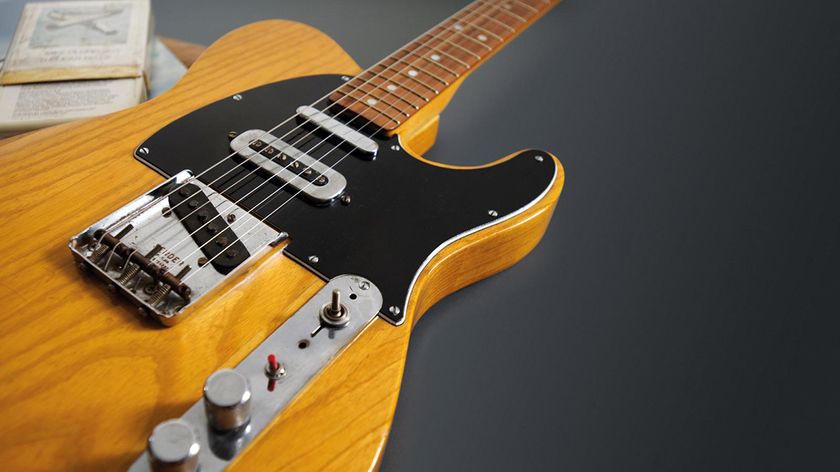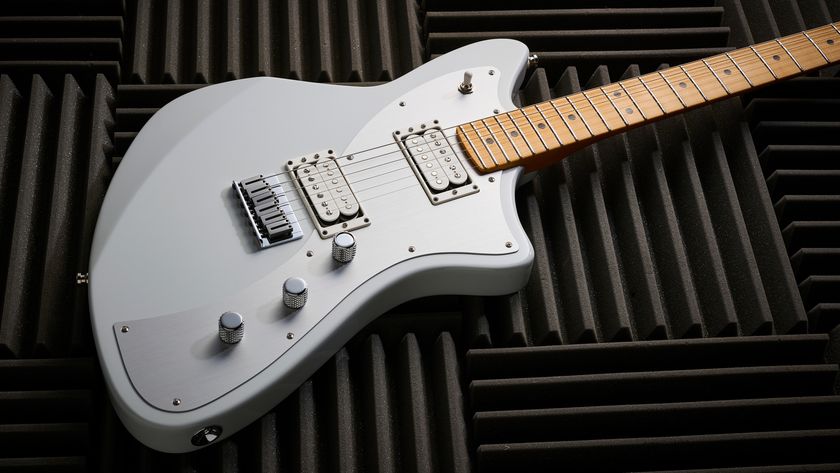St. Vincent Discusses Her New Signature Ernie Ball Music Man Guitar

In March, Annie Clark, a.k.a. St. Vincent, will join the likes of Albert Lee, John Petrucci and Steve Morse as the next in a line of genre-defining artists to release their own signature guitars with Ernie Ball Music Man.
Made with a body of African mahogany and a rosewood neck, the St. Vincent signature guitar will debut in one of two colors, either black or Vincent Blue—a shade that was hand-mixed by Clark herself—and comes fully equipped with three mini-humbuckers and a custom Music Man tremolo system.
With its slim and tapered waist, stylishly retro design and instantly playable feel, the Ernie Ball Music Man St. Vincent model is a thoroughly unique instrument.
It’s a big win for Ernie Ball and an even bigger win for Clarke’s many fans and acolytes.
From her humble beginnings playing around Dallas, Texas, as a young girl, in the past five years she’s really etched out a name for herself playing her own instantly identifiable jagged, new-wave revivalist sound and paved the way for so many individually minded artists following in her wake. By critical consensus, her self-titled record was one of the most lauded and celebrated releases of 2014.
Beyond the Grammy nominations and critics’ best-of lists, however, for Clarke, the opportunity to create a guitar with her name on it based off of some of her favorite designers and design movements from the Eighties was a real “dream come true.” Of course, instruments are about far more than aesthetics and Clark made it her mission to create something that would elevate both her own playing and the playing of anyone who picks it up and plugs it in.
“If you have a great instrument you’re going to play better,” she says. “You’re going to play up to the level of the instrument because it makes it easier for you to succeed.”
Get The Pick Newsletter
All the latest guitar news, interviews, lessons, reviews, deals and more, direct to your inbox!
At what point were you approached by Ernie Ball Music Man about creating your own signature instrument?
It was in the early spring of 2015 that they reached out about it and the second I found out about Ernie Ball potentially making a signature guitar I jumped at the chance. I was so excited.
What was the first step for you?
I went to the factory, got a tour, saw how everything was made, saw the working conditions, which were quite good—it’s a living wage company. I saw that if I was going to do business with them I would not have to hold my nose in any way, shape or form. They do good business and treat people well, which is very important to me as a small business owner.
From the beginning, was it made clear how much freedom you would be afforded in the design process?
I really had total free reign. I could have revamped one of their existing models or started from scratch and done my own. I ended up just starting from scratch. My particular guitar is based a lot on [Eighties German synthpop artist] Klause Nomi’s aesthetic, the Memphis design movement, which was an [Eighties] Italian design movement, those Sixties and Seventies Japanese designed guitars like the Tescos and then I went for classic car colors. I really like cars so I went for a ’67 Corvette with the color scheme.
At a little over seven pounds, this isn’t a very heavy guitar. How important was it for you to create an instrument that is on the lighter side?
For me a guitar that is not too heavy is really important because I’m not a very big person. I can’t even play a Sixties Strat or Seventies Les Paul. I would need to travel with a chiropractor on tour in order to play those guitars. It’s not that those aren’t great guitars, but they render themselves impractical and unfunctional for a person like me because of their weight.
They’re prohibitive, so this is a very light guitar and the weight is redistributed so that it has a thin waist. I was always finding when I was playing onstage and wearing various stage outfits the guitar would cut across one of the best features of the female body, which is your waist. I carry my guitar pretty high so I had to make all of these costumes based on the fact that you wouldn’t be able to see if I had a waist or not. I wanted to make something that looked good and not just on a woman, but any person. And again, I consulted Klause Nomi and some of my favorite Eighties designs to accommodate that.
There’s a real minimalist vibe with this guitar. It’s got three mini-humbuckers, a tremolo system, and only two knobs and a selector switch. Was it your goal to try and pare things down?
Yeah. It was partially visual design and partly just simply what I use. I wanted it to remain fairly chopped. You have one tone knob, you have one volume knob, you have three mini-humbuckers so you get five different configurations of sound and it really has a whole lot of tone flexibility as a result. It’s sort of wired in a counterintuitive way, but I think it’s the best use of those particular pickup configurations.
Do you generally play more in the neck, middle or bridge position?
I usually play in the middle position.
Was there a specific designer that you were working with at Ernie Ball or was it more of a team effort?
I definitely got some input from [senior engineer] Drew Montell and Sterling Ball. I would send them an idea and they would go, “Okay, here’s an option, here’s an option, here’s an option. Here’s how we can make it three percent bigger.” And then there’s so much beta testing involved to make sure that once we get it to market that it’s the best possible tool and the most flexible tool.
Things like, because the shape is slightly unorthodox, making sure that the weight distribution between the neck and the body is just right and the most comfortable, so we messed with different kinds of tuning knobs to get the weight down even further. We talked about the particular hardware on it and the materials we could use with both design and weight and functionality all in mind. It’s been a very intensive process. So far we’ve easily gone through nine, 10, 11, 12 prototypes just to make sure we end up with the best thing possible.
How long did all of that take?
When I went to the Ernie Ball factory I drew a design that day and I think within a week we had a finished prototype. And then from there it’s just been back and forth, back and forth, back and forth; refine, proof of concept, refine, refine, refine.
How did it feel when you finally got the finished product in your hands, knowing your name would be on it and it would go into the hands of other people to create their own music?
The feeling of when you’re a kid and walking into a guitar store and seeing all of those shapes and models and colors, it’s better than a candy store. You feel the possibility, you feel the excitement, you superimpose your feelings onto every guitar, and not just, “What will I sound like with this guitar? What song will I write with this guitar?” But, “How will I look onstage with that guitar?” It’s just so magic and it never gets old to me, so the idea that I have the guitar especially designed for my needs, but that my needs are transferrable and other people will get to enjoy it and have the same kind of connection with it that I do is just a dream come true.
It’s an unfortunate reality that there aren’t many women in music that have their own signature instruments. Nancy Wilson of Heart comes to mind, as does Joan Jett, but you’re one of the first women to design your own guitar from the ground up.
Well I’m certainly glad to be a beacon for women and for anybody who likes music and my music. I’m glad that another guitar exists that is sympathetic to the female form. I’m glad that that exists and I hope that people will enjoy…that men and women will enjoy the ergonomics. But smaller people and women especially.
Is it true that you played this guitar out in public for the first time at a Taylor Swift concert?
Yeah [see the video below], that was really fun and really wild because I’m used to playing for crowds, and I think I’ve maxed out at a festival crowd of about 20,000, maybe? Maybe more or maybe less, but to walk onstage and be in front of 35,000 screaming fans, most of them girls, and her fans are so generous and so up for anything. If Taylor says “Jump,” they’ll say, “How high?” She’s got a really rabid and awesome fan base.
For more about this guitar, visit its page at music-man.com.





“What's incredible about this guitar is that it was Marc Bolan's before. That's a double whammy”: Mike Oldfield’s Tubular Bells Telecaster has cropped up on the BBC's Antiques Roadshow – after it was bought for $12,500

“One of the best legitimately new guitars Fender has produced in decades – despite one painfully positioned volume control”: Fender American Ultra II Meteora review
Most Popular









